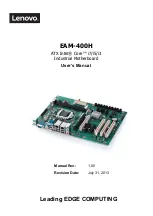
ATXN-5520 / WTM7026 Technical Reference
BIOS Messages
A-9
Chassis Plans
P
OST
C
ODE
C
HECKPOINTS
The POST code checkpoints are the largest set of checkpoints during the BIOS pre-boot process. The table
below describes the type of checkpoints that may occur during the POST portion of the BIOS. Refer to the
chart in the previous section to interpret the hexadecimal values of POST code LEDs 1 through 8.
Checkpoint
Description
03
Disable NMI, parity, video for EGA and DMA controllers. Initialize BIOS, POST,
Runtime data area. Also initialize BIOS modules on POST entry and GPNV area.
Initialize CMOS as mentioned in the Kernel Variable “wCMOSFlags.”
04
Check CMOS diagnostic byte to determine if battery power is OK and CMOS
checksum is OK. Verify CMOS checksum manually by reading storage area. If the
CMOS checksum is bad, update CMOS with power-on default values and clear
passwords. Initialize status register A. Initialize data variables that are based on
CMOS setup questions. Initialize both the 8259 compatible PICs in the system.
05
Initialize the interrupt controlling hardware (generally OPIC) and interrupt vector
table.
06
Do read/write test to CH-2 count register. Initialize CH-0 as system timer. Install
the POSTINT1Ch handler. Enable IRQ-0 in PIC for system timer interrupt. Traps
INT1Ch vector to “POSTINT1ChHandlerBlock.”
08
Initialize the processor. The BAT test is being done on KBC. Program the
keyboard controller command byte is being done after auto detection of
keyboard/mouse using AMI KB-5.
0A
Initialize the 8042 compatible keyboard controller.
0B
Detect the presence of PS/2 mouse.
0C
Detect the presence of keyboard in KBC port.
0E
Testing and initialization of different input devices. Also, update the Kernel
variables. Traps the INT09h vector, so that the POST INT09h handler gets control
for IRQ1. Uncompress all available language, BIOS logo and silent logo modules.
13
Early POST initialization of chipset registers
24
Uncompress and initialize any platform specific BIOS modules.
30
Initialize System Management Interrupt.
2A
Initialize different devices through DIM. See
DIM Code Checkpoints
section of this
appendix for more information.
2C
Initialize different devices. Detects and initializes the video adapter installed in the
system.
2E
Initialize all the output devices.
31
Allocate memory for ADM module and uncompress it. Give control to ADM
module for initialization. Initialize language and font modules for ADM. Activate
ADM module.
33
Initialize the silent boot module. Set the window for displaying text information.
37
Display sign-on message, processor information, setup key message and any
OEM specific information.




































